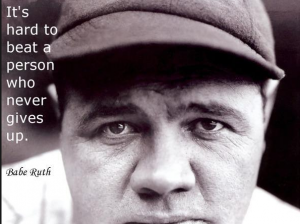How The Babe Can Improve Risk Mitigation At Your Bank
It was 102 years ago, almost to the day, that Babe Ruth hit his first home run as a Yankee against his previous team, the Boston Red Sox. That hit launched a juggernaut that not only changed baseball but changed the view of both team building and risk mitigation. In this article, we highlight the not-so-obvious lessons in banking learned from the New York Yankees when they managed the Sultan of Swat.
Paying For Performance
The day after Christmas in 1919, the Boston Red Sox transferred George Herman Ruth to the NY Yankees for the princely sum of $100,000. While this might have started the 86-year Curse of the Bambino for the Sox, the Yankees leveraged the Babe to their advantage. In the contract, in addition to the Babe’s $5,000 annual salary, the team inserted the language to pay Ruth $50 for each home run. It was a simple sentence that changed the whole game of baseball.
Any student of behavioral economics could predict what would happen next – Babe Ruth started swinging for the fences and taking risks he had never taken before. Since he had little downside with his locked-in contract and only upside, he took chances. Instead of hitting 29 home runs as he did in the season before, he almost doubled his production and hit 54 (and 59 the next year). At $50 a home run, he earned more than 50% of his salary in each year of his contract by hitting white balls into the stands.

Developing A Risk-Taking Culture
Of course, he struck out almost 80% more times which would have scared many managers. Yankee management told him to keep swinging. As Ruth said, “I learned never to let the fear of striking out get in my way.” The other interesting thing that happened is that he started to gamble, running for home. Ruth held at 3rd 25% less than before, as he took a chance to try to make it home to earn his incentive. This also paid off as he made it home more times than tagged.
Ruth’s newfound confidence started to permeate everything he did as the Yankees promoted a culture of taking chances. Before the 1920 season, Ruth was never caught stealing a base. Now, since it was OK to take a risk, he doubled the number of bases stolen, which paid off even though he was caught stealing 14 times.
Risk Mitigation Through Production
The Yankees essentially let Ruth be Ruth which is the other side of risk management. It would have been more of a risk to do anything else. That simple sentence that tied Ruth’s compensation to production, while novel for the time, was not wholly new. What was novel was the risk-taking culture. The position paid off as the Yankees went on to win their first pennant in the team’s history and were the first team in baseball to have over one million fans. Like the Babe, your all-star lenders and deposit gathers should swing for the fences too, and the bank should strive to place as little drag on them as possible.
Risk Mitigation Through Resources
Sound risky to incentivize your lenders to take on more risk? It is, and the Yankees understood this as well. Yankee owner Jacob Ruppert and skipper Miller Huggins knew what they were doing with the Bambino. Knowing the risk, they also brought in a young kid, Bob Meusel, that was pretty good at getting on base, not to mention able to help Ruth in the outfield and have his back in fights. Ruth, along with Meusel, Wally Schang, Elmer Miller, Aaron Ward, and others, worked together to lower the overall risk of Ruth hitting a slump. By bringing on Ruth, not only did the whole team play better, but the organization attracted critical talent – Success fueled further success.
Risk Mitigation Through Strategy
Strategy matters. Ruth was a pretty good pitcher and was in the Red Sox’s rotation. However, it was Manager Huggins that understood that while having Ruth pitch may help, the highest and best use for the Big Bam was to have him swing. Like keeping a good business development officer stuck in the office moving around paper, having Ruth as a pitcher limited his time at-bat, which hurt his value.
Putting This into Action
Managing resources around risk is another important lesson in risk mitigation that banks can learn from the Babe. Risk management is more than putting constraints on production. While a manager might have set a complicated formula in Ruth’s contract that provided a balanced scorecard of runs, outs, batting percentages, and other metrics, simplicity was best in this case. Ruth immediately got it and adjusted his behavior. Sometimes risk management is nothing more than getting offensive and then increasing the resources devoted to managing credit or surrounding your lenders with team players than can help reduce the risk through underwriting, structuring, and improved active credit management.
While you may not be fielding the Yankees, the lesson from the Babe can apply to any bank. Superior performance starts by putting the right culture in place, the right incentives, the proper risk management, and strategy. As the Boston Red Sox will tell you, sometimes being too risk-averse is the riskiest strategy of them all.

